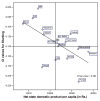Nutritional status of children in India: household socio-economic condition as the contextual determinant
- PMID: 20701758
- PMCID: PMC2931515
- DOI: 10.1186/1475-9276-9-19
Nutritional status of children in India: household socio-economic condition as the contextual determinant
Abstract
Background: Despite recent achievement in economic progress in India, the fruit of development has failed to secure a better nutritional status among all children of the country. Growing evidence suggest there exists a socio-economic gradient of childhood malnutrition in India. The present paper is an attempt to measure the extent of socio-economic inequality in chronic childhood malnutrition across major states of India and to realize the role of household socio-economic status (SES) as the contextual determinant of nutritional status of children.
Methods: Using National Family Health Survey-3 data, an attempt is made to estimate socio-economic inequality in childhood stunting at the state level through Concentration Index (CI). Multi-level models; random-coefficient and random-slope are employed to study the impact of SES on long-term nutritional status among children, keeping in view the hierarchical nature of data.
Main findings: Across the states, a disproportionate burden of stunting is observed among the children from poor SES, more so in urban areas. The state having lower prevalence of chronic childhood malnutrition shows much higher burden among the poor. Though a negative correlation (r = -0.603, p < .001) is established between Net State Domestic Product (NSDP) and CI values for stunting; the development indicator is not always linearly correlated with intra-state inequality in malnutrition prevalence. Results from multi-level models however show children from highest SES quintile posses 50 percent better nutritional status than those from the poorest quintile.
Conclusion: In spite of the declining trend of chronic childhood malnutrition in India, the concerns remain for its disproportionate burden on the poor. The socio-economic gradient of long-term nutritional status among children needs special focus, more so in the states where chronic malnutrition among children apparently demonstrates a lower prevalence. The paper calls for state specific policies which are designed and implemented on a priority basis, keeping in view the nature of inequality in childhood malnutrition in the country and its differential characteristics across the states.
Figures
Similar articles
-
Socio-economic inequality in malnutrition among children in India: an analysis of 640 districts from National Family Health Survey (2015-16).Int J Equity Health. 2019 Dec 27;18(1):203. doi: 10.1186/s12939-019-1093-0. Int J Equity Health. 2019. PMID: 31881899 Free PMC article.
-
Inequality in child undernutrition among urban population in India: a decomposition analysis.BMC Public Health. 2020 Dec 3;20(1):1852. doi: 10.1186/s12889-020-09864-2. BMC Public Health. 2020. PMID: 33272222 Free PMC article.
-
Changes in socio-economic inequality in nutritional status among children in EAG states, India.Public Health Nutr. 2021 Apr;24(6):1304-1317. doi: 10.1017/S1368980021000343. Epub 2021 Jan 27. Public Health Nutr. 2021. PMID: 33500017 Free PMC article.
-
Prevalence of malnutrition among children and women of reproductive age in Uruguay by socio-economic status and educational level.Public Health Nutr. 2020 Aug;23(S1):s101-s107. doi: 10.1017/S1368980020000804. Epub 2020 Apr 17. Public Health Nutr. 2020. PMID: 32299530 Free PMC article. Review.
-
Do nutrition and cash-based interventions and policies aimed at reducing stunting have an impact on economic development of low-and-middle-income countries? A systematic review.BMC Public Health. 2019 Oct 30;19(1):1419. doi: 10.1186/s12889-019-7677-1. BMC Public Health. 2019. PMID: 31666032 Free PMC article.
Cited by
-
Possibility of the optimum monitoring and evaluation (M&E) production frontier for risk-informed health governance in disaster-prone districts of West Bengal, India.J Health Popul Nutr. 2024 Sep 17;43(1):148. doi: 10.1186/s41043-024-00632-1. J Health Popul Nutr. 2024. PMID: 39289762 Free PMC article.
-
Multidimensional poverty and child survival in India.PLoS One. 2011;6(10):e26857. doi: 10.1371/journal.pone.0026857. Epub 2011 Oct 27. PLoS One. 2011. PMID: 22046384 Free PMC article.
-
Intersectional role of paternal gender-equitable attitudes and maternal empowerment in child undernutrition: a cross-sectional national study from India.BMJ Open. 2021 Aug 5;11(8):e047276. doi: 10.1136/bmjopen-2020-047276. BMJ Open. 2021. PMID: 34353796 Free PMC article.
-
Trends in inequalities in child stunting in South Asia.Matern Child Nutr. 2018 Nov;14 Suppl 4(Suppl 4):e12517. doi: 10.1111/mcn.12517. Epub 2017 Oct 19. Matern Child Nutr. 2018. PMID: 29048726 Free PMC article.
-
Malnutrition and infant and young child feeding in informal settlements in Mumbai, India: findings from a census.Food Sci Nutr. 2015 May;3(3):257-71. doi: 10.1002/fsn3.214. Epub 2015 Mar 3. Food Sci Nutr. 2015. PMID: 25988001 Free PMC article.
References
-
- World Bank. Quantitative Techniques for Health Equity Analysis. Technical Note. 2003, No.2.
-
- Shiva Kumar AK. Why are child malnutrition levels not improving? Opinion-Leader Page Articles. The Hindu; 2007. Saturday.
-
- Pathak PK, Singh A. In: Population, poverty and health: analytical approaches. Singh KK, Yadava RC, Pandey A, editor. Hindustan Publishing Corporation, New Delhi, India; 2009. Geographical variation in poverty and child malnutrition in India.
LinkOut - more resources
Full Text Sources




